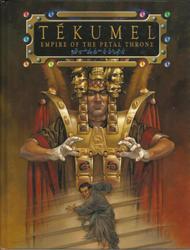 |
| Vlad III. aka Vlad Tepes ("the Impaler"), aka Vlad Dracula, aka Mr. Sunnyboy McMagicpants |
That's right kiddies. I'm bringing back old school, blood-sucking-fiends-from-beyond-the-grave for this setting. I'm taking a stand with every other horror fan who despises what vampires have become; no more undead goths or glittery, immortal, crypto-Mormons who spread abstinance-only sex-ed and anti-abortion propaganda. (Kiss my atheist ass, Ms. Meyers.)
Besides the standard-issue Homo sapiens, I'm considering other races to replace the usual, but inappropriate for this setting, metahumans. One of the races that's top on my list candidates are the Dhampir: the offspring of humans and vampires. Now, Pathfinder already have Dhampirs as one of their "Advanced" racial option and I used it as a good place to draw some inspiration.
My end result is the following, which is suitable for any of the more "Advanced" OSR games that have races and classes seperate:
Dhampir:
STR +2, DEX +2 CON -2, CHA +2
- Darkvision up to 60 feet.
- Attacks by Dhampir on any undead creature counts as "magical" even when using mundane weapons.
- Dhampir have a 4-6 chance of sensing the presence of an undead creature within 100 ft.
- Dhampir are truly children of the night. While they are not injured by sunlight like their vampire parent, they are weaker when exposed to it. Dhampir suffer a -2 modifier to all rolls when exposed to daylight.
- Dhampir have the characteristic fangs of their vampire ancestry and can inflict1d4 damage per bite. They may drain blood (see below) on the their next turn, but if it's taken as their only action.
- Dhampir do not heal damage naturally, nor can they be healed through potions, spells, or spell-like devices. They can only be healed by ingesting human blood from a living host at a rate of 1d4 HP per round of drinking. However, with each turn they spend drinking, they must make a Saving Throw vs. Death or fall under the spell of the Blood Frenzy (see below). Those slain in this manner DO NOT return as vampires.
- The Blood Frenzy: While not necessarily needing it to live, Dhampir often feel their ancestral craving for blood as well as the orgasmic thrill of consuming it. If the Dhampir is not careful while drinking blood, they will loose control of themselves and seek out more--even from the throat of a friend. When in the Blood Frenzy, a Dhampir PC will attack the nearest living human character, friend or foe, and attempt to to bite and feed on them for 1d6 rounds, until killed, or otherwise subdued. Afterward, the Dhampir must rest for 1d4 hours to recover from experience, or suffer a -2 modifer to all rolls until they do so.
Allowed classes include Fighter, Magic-User, Assassin, and Thief. Paladins and Clerics are right out. They can be good or evil, but tend toward neutral or chaotic alignments.
I'm sort of wondering if this is properly balanced. I choose to add the STR bonus because, unlike Pathfinder, Strength is the modifier for melee combat in most OSR games and I see vampires as more toe-to-toe fighters than marksmen for obvious reasons. I can go either way on the DEX bonus; however, whoever heard of a sluggish vampire? The CON reduction is due to their undead parentage making them somewhat sicklier than normal humans. Of course, in the modern media, Vampires are usually portrayed as attractive (better to lure unsuspecting victims to their deaths, dearie) so I'll give their children that bonus as well.
So there you have it! Leave comments and ideas in the comments below. I'm post more as it comes into my fevered brain. I don't know how I'm going to handle the rules for creepy, pedophile, werewolves, though.


